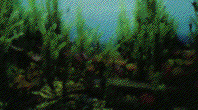The Ordovician Mass Extinction

Fast Facts
- Ordovician period (510-
438 million years ago)
- Ordovician extinction (440-450 million years ago)
- Ordovician extinction was second most devastating in earth history
Geological Setting
The Ordovician period was an era of extensive diversification and expansion of numerous marine clades. Although organisms also present in the Cambrian were numerous in the Ordovician, a variety of new types including cephalopods, corals (including rugose and tabulate forms), bryozoans, crinoids, graptolites, gastropods, and bivalves flourished. Ordovican communities typically displayed a higher ecological complexity than Cambrian communities due to the greater diversity of organisms. However, as in the Cambrian, life in the Ordovician continued to be restricted to the seas.
Species Affected
The Ordovician extinction occurred at the end of the Ordovician period, about 440-450 million years ago. This extinction, cited as the second most devastating extinction to marine communities in earth history, caused the disappearance of one third of all brachiopod and bryozoan families, as well as numerous groups of conodonts, trilobites, and graptolites. Much of the reef-building fauna was also decimated. In total, more than one hundred families of marine invertebrates perished in this extinction.
 Causes of the Ordovician Extinction
Causes of the Ordovician Extinction
 Mass Extinctions of the Phanerozoic Menu
Mass Extinctions of the Phanerozoic Menu
 Main Menu
Main Menu